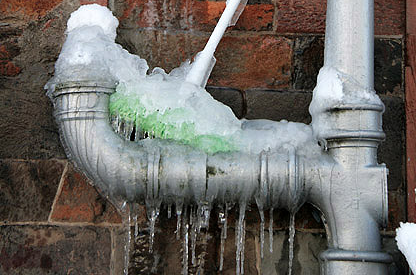Ways to Prevent Frozen Plumbing in Winter: Expert Guidance
Ways to Prevent Frozen Plumbing in Winter: Expert Guidance
Blog Article
We've noticed this article on 6 Ways to Prevent Frozen Pipes directly below on the web and thought it made good sense to discuss it with you over here.

Cold weather can ruin your plumbing, specifically by freezing pipes. Right here's exactly how to avoid it from occurring and what to do if it does.
Intro
As temperature levels drop, the risk of frozen pipelines rises, potentially resulting in costly fixings and water damages. Understanding just how to avoid frozen pipelines is important for property owners in cool climates.
Recognizing Frozen Pipelines
What triggers pipelines to freeze?
Pipelines freeze when subjected to temperature levels below 32 ° F (0 ° C) for expanded periods. As water inside the pipes ices up, it expands, putting pressure on the pipeline wall surfaces and potentially causing them to break.
Threats and damages
Frozen pipelines can cause supply of water interruptions, property damage, and costly repair services. Ruptured pipelines can flooding homes and create extensive structural damage.
Signs of Frozen Pipeline
Determining frozen pipes early can prevent them from bursting.
Exactly how to identify frozen pipelines
Try to find lowered water flow from taps, uncommon smells or sounds from pipes, and visible frost on exposed pipes.
Prevention Tips
Shielding vulnerable pipelines
Cover pipelines in insulation sleeves or use heat tape to safeguard them from freezing temperatures. Concentrate on pipelines in unheated or external locations of the home.
Home heating strategies
Keep interior spaces effectively heated, specifically areas with plumbing. Open up cabinet doors to enable cozy air to circulate around pipelines under sinks.
Protecting Outside Pipes
Yard hoses and outside taps
Separate and drain pipes garden hose pipes before winter months. Mount frost-proof spigots or cover outdoor faucets with insulated caps.
What to Do If Your Pipes Freeze
Immediate actions to take
If you think frozen pipes, keep faucets open to ease pressure as the ice melts. Utilize a hairdryer or towels soaked in hot water to thaw pipes gradually.
Long-Term Solutions
Architectural modifications
Take into consideration rerouting pipes far from outside walls or unheated locations. Include extra insulation to attic rooms, basements, and crawl spaces.
Upgrading insulation
Invest in top quality insulation for pipes, attics, and walls. Proper insulation helps maintain consistent temperature levels and lowers the threat of frozen pipelines.
Conclusion
Preventing frozen pipelines needs aggressive steps and fast responses. By comprehending the reasons, signs, and safety nets, homeowners can safeguard their pipes throughout winter.
5 Ways to Prevent Frozen Pipes
Drain Outdoor Faucets and Disconnect Hoses
First, close the shut-off valve that controls the flow of water in the pipe to your outdoor faucet. Then, head outside to disconnect and drain your hose and open the outdoor faucet to allow the water to completely drain out of the line. Turn off the faucet when done. Finally, head back to the shut-off valve and drain the remaining water inside the pipe into a bucket or container. Additionally, if you have a home irrigation system, you should consider hiring an expert to clear the system of water each year.
Insulate Pipes
One of the best and most cost-effective methods for preventing frozen water pipes is to wrap your pipes with insulation. This is especially important for areas in your home that aren’t exposed to heat, such as an attic. We suggest using foam sleeves, which can typically be found at your local hardware store.
Keep Heat Running at 65
Your pipes are located inside your walls, and the temperature there is much colder than the rest of the house. To prevent your pipes from freezing, The Insurance Information Institute suggests that you keep your home heated to at least 65 degrees, even when traveling. You may want to invest in smart devices that can keep an eye on the temperature in your home while you’re away.
Leave Water Dripping
Moving water — even a small trickle — can prevent ice from forming inside your pipes. When freezing temps are imminent, start a drip of water from all faucets that serve exposed pipes. Leaving a few faucets running will also help relieve pressure inside the pipes and help prevent a rupture if the water inside freezes.
Open Cupboard Doors
Warm your kitchen and bathroom pipes by opening cupboards and vanities. You should also leave your interior doors ajar to help warm air circulate evenly throughout your home.

Do you enjoy reading up on How To Avoid Freezing Pipes? Give a comment below. We'd be pleased to listen to your responses about this content. We hope to see you back again soon. Sharing is caring. Helping others is fun. We take joy in your readership.
Suggested Site Report this page